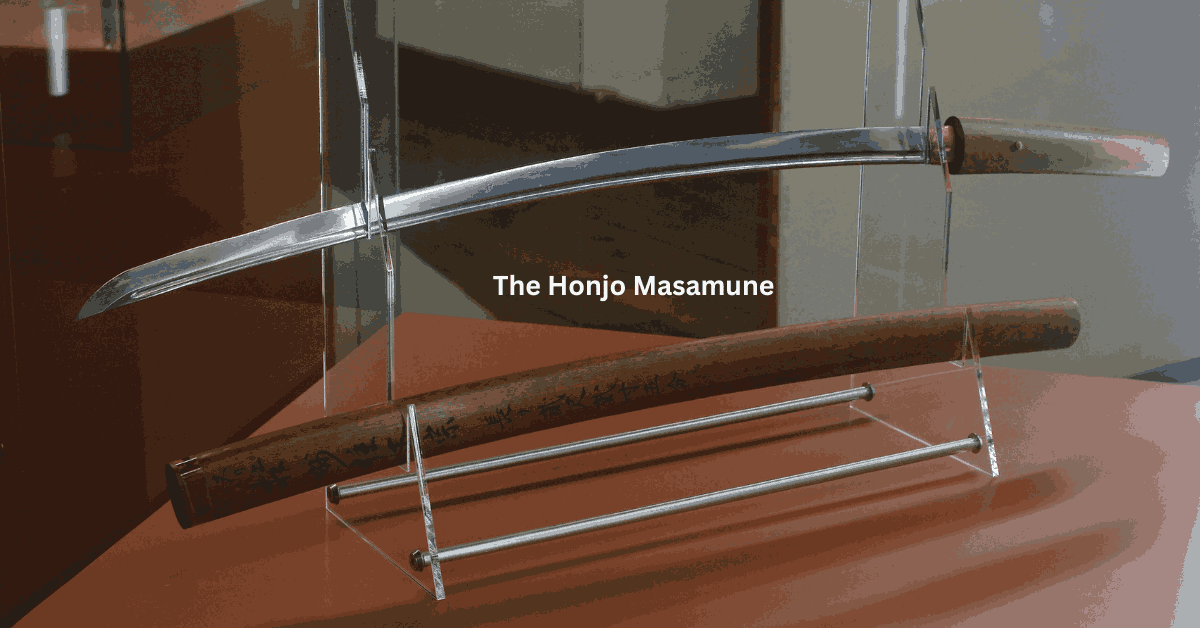The Honjo Masamune is more than a sword men, it is a legend. Other legendary weapons like Excalibur or Achilles’ armor like it too has a legend behind it. Where the Honjo Masamune distinguishes itself from the legends is that the Honjo Masamune is an authentic sword, but other legendary weapons are completely mythological, but its location remains one of the world’s largest mysteries.
This is the tale of the Honjo Masamune; a samurai-forged masterpiece sword from samurai to samurai and into the centuries.
Contents
- 1 The Honjo Masamune and its Master: Gorō Nyūdō Masamune
- 2 The Making of the Honjo Masamune Masterpiece
- 3 A Weapon Named After a Warrior
- 4 The Emblem of the Tokugawa Shogunate
- 5 The Honjo Masamune and the Tale of Two Swordsmiths
- 6 The Sword That Vanished
- 7 Theories Behind Its Disappearance
- 8 Legacy in Modern Japan and Pop Culture
- 9 A Treasure Still Waiting to Be Found
- 10 Conclusion
The Honjo Masamune and its Master: Gorō Nyūdō Masamune
To understand why the Honjo Masamune is significant, we must start with sword’s maker: Gorō Nyūdō Masamune. Gorō Nyūdō Masamune is the individual who is widely regarded as the finest swordsmith in Japanese history, yet he is ultimately a figure of mystery, made swords during the very late Kamakura period (around 1288–1328) when steel making had a variety of issues to deal with.
He was, nonetheless, capable of creating swords of great beauty, strength, and quality that few could manage.
Masamune operated from Sagami Province (the contemporary Kanagawa Prefecture) and mastered folding and tempering steel to the extent that the result was handsome, deadly, and functional swords. His swords inherently showed sharpness, perfection, and unique hamon, the appearance of tempering and rendered the sword distinct.
More than 700 years later, we still know Masamune’s name. The Masamune Prize that is awarded at Japanese sword-making competitions is widely considered the highest honor of the contemporary swordsmith.
The Making of the Honjo Masamune Masterpiece

The Honjo Masamune is generally considered the finest of Masamune’s many creations. As previously mentioned, many of Masamune’s swords did not have a signature, either out of a sense of humility, or because it was a common practice for the period.
Some people think Masamune did sign this sword; either in the first instance, or perhaps later at some point in its life.
The Honjō Masamune was made in the traditional Japanese style of sword at the time, having a single-edged curved blade, which is likely around 65 cm long (about 25.6 inches) with a small curve.
Japan’s Honjo Masamune was made through multiple rounds of hardening and folding, producing a sword that would give the finest cutting action along with its structural rigidity.
While it’s impossible to know the exact of course measurements, they differ from account to account; the sword was said to be almost perfect, a marriage of deadly, useful artifact, and aesthetic beauty.
This sword, even if not a weapon, was regarded as a national jewel, not only intrinsically fine in its technical construction, but of its stories and heritage.
A Weapon Named After a Warrior
The sword’s name is derived from Honjō Shigenaga (1570-1647), a famous warrior of the late Sengoku period, a time when Japan was engulfed in near-constant civil war.
During the mid-1500s, in a fierce battle at Kawanakajima, Shigenaga was assaulted by a man with a Masamune forged sword, which broke Shigenaga’s helmet into two pieces, but did not kill him. Shigenaga then proceeded to kill the challenger and take the sword for himself.
It was remarkable that the sword could cleave a helmet apart without killing the target, speaking to its cutting power but also, perhaps symbolically, restraint, and there are many reasons the sword was believed to be a weapon of nobility rather than butchery.
Eventually, Shigenaga ran into financial challenges, and let the blade go, where it came into the hands of the Tokugawa family, and it would become something much more than a simple piece of history.
The Emblem of the Tokugawa Shogunate
Tokugawa Ieyasu, who is considered to be the unifier of Japan and the founder of the Tokugawa Shogunate, ushered in a new era of Japan after decades of war since the early 17th century, under the Tokugawas for more than 250 years.
Tokugawa family also owned one of the most famous Japanese swords – Honjō Masamune, which represented rightful authority and direct rule from the Emperor.
Over the centuries, the sword was passed down from shogun to shogun based on the sword’s intrinsic value (as a beautiful sword) and its representational value of the Tokugawa reign’s power and stability.
The sword was well-respected, on par with the other priceless cultural treasures, and was officially designated a National Treasure of Japan in 1939.
The Honjo Masamune and the Tale of Two Swordsmiths
In one of the most enduring sword stories – which pits Masamune’s tranquil philosophy against his rival Muramasa’s beliefs in blood lust and violence – the Honjō Masamune plays a prominent role.
In the legend, Masamune and Muramasa forged blades, and to see whose blade cut the best, they both suspended the two blades in a stream. Muramasa’s blade cut everything that floated by from leaves to fish, as well as even the air (which Masamune could not comprehend). Masamune’s blade cut only the leaves, as the fish floated by unharmed.
A monk who had been observing the contest ruled in favor of Masamune for making the better sword. Why was it better?
Because it cut when it needed to and it restrained and possessed wisdom and restraint that were appropriate characteristics for a true warrior’s blade.
Muramasa’s blade was considered bloodthirsty and was cursed. Many believed that once drawn, a Muramasa blade had to have blood on it before it could be sheathed again.
Although the story is apocryphal, it solidified the image of the Honjō Masamune as a sword with not only immense power, but also immense virtue.
The Sword That Vanished
In the aftermath of World War II, Japan found itself again under the rule of the Allied Occupation. The overall orders given to the Japanese were to surrender all arms of every sort, including traditional swords and any swords that noble families had owned for hundreds of years.
In 1945 the head of the Tokugawa family, Tokugawa Iemasa surrendered the family sword and other culturally prized heirlooms.
These included the Honjō Masamune sword. There are reports describing the sword being transferred to an officer in the U.S. Army, Sgt. Coldy Bimore of the 7th Cavalry regiment.
This is where the trail ends.
There is no official record of a “Coldy Bimore” serving either at that time in the regiment, or anywhere else in the U.S. military. He was either using a falsified name, or it was incorrectly recorded in some other way. Whatever the reason, the Honjō Masamune has disappeared and has not been seen since.
Theories Behind Its Disappearance
Over the years, many theories have been offered as to what happened to the Honjō Masamune. Some believe it was destroyed carelessly, possibly melted down along with other seized blades as scrap. Some are positive that it was secretly whisked out of Japan and is now likely hidden or “lost” in someone’s private collection in the U.S. or Europe.
Others believe that it is sitting in a museum archive where, like so many other historical objects in the museum, it has been misplaced or forgotten. Even though some leads and rumors have surfaced, there have not been any confirmed sightings of the sword.
In recent have been increasing interest on tracking the sword down, and with collectors, historians, and even Japanese government agencies, there is perhaps some hope that it may one day find its way back to the public.
Legacy in Modern Japan and Pop Culture
Although once held in our material world, Honjō Masamune‘s sword has now transformed into an icon – a standard bearer for both the craftsmanship, and for what it means to be culturally aware and fully engaged with one’s own national identity.
The sword has taken on a life of its own in video games, in anime, literature, and typically with some notion of mysterious or spiritual powers.
Video games both real and conceptual like Final Fantasy, Ghost of Tsushima, and numerous history drama productions have brought back the history of Masamune’s swords. How the sword would have appeared will always be a mystery to individuals worldwide, not just for its renowned beauty but most likely the mystery that it holds.
A Treasure Still Waiting to Be Found
The tale of the Honjō Masamune contains so many facets: creativity, legacy, war, and loss, to name a few. It reminds us of how fleeting even the pinnacles of our fellow human beings are in the maelstrom of history,
But it also leaves a long-lasting sense of hope, perhaps, someday the sword will emerge from the shadows and take its rightful place as one of the most precious cultural objects in the world.
As the world continues to move towards having cultural issues around preservation, the Honjō Masamune is, by a long measure, the most coveted artifact that is currently missing from our planet.
The discovery of the Honjō Masamune would be a triumph for historians, but it would also provide a more therapeutic moment for a nation that deeply connects to the sword’s positioning in time.
Conclusion
The Honjo Masamune is more than a marvel of metallurgy. It is living history—a symbol of precision, restraint, and honor. Although now lost, it has only increased in legend. And the longing to get this amazing sword back in our story increases every year.
For more on mysterious historical events and lost artifacts, check out our other post: Ming the Clam’s Accidental Death Explained.


2 thoughts on “The Honjo Masamune – A Masterpiece of Japanese Swordmaking”